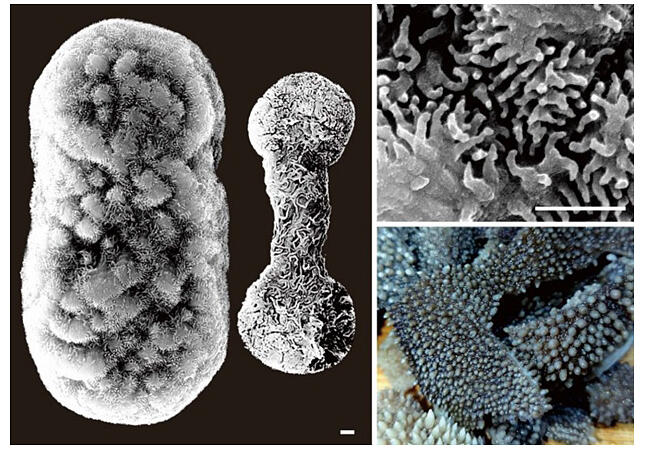The research group of Tatsuki Koido and Yukimitsu Imahara of the Kuroshio Biological Research Foundation, and Professor Hironobu Fukami of the Faculty of Agriculture at the University of Miyazaki has discovered a new species of soft coral in the genus Sympodium. It was collected around Nichinan Oshima Island in Nichinan City, Miyazaki Prefecture, Japan, and found to be a new species through molecular phylogenetic and morphological taxonomic studies. This new species was given the scientific name Sympodium omasum and the Japanese name Senmai-Chijimiumiazami for the following reasons: the sclerites on its body have characteristics largely distinct from those of other species of the genus Sympodium (Chijimiumiazami in Japanese); the surface of the sclerites resembles the omasum (senmai in Japanese), which is the third stomach of cattle; and the specimen was collected in Miyazaki Prefecture, a production area of Miyazaki wagyu beef. The results were published in the online edition of Zootaxa.

Two types of sclerites, a platelet sclerite and a double-headed sclerite, are depicted on the left, and the surface structure of a sclerite specific to Sympodium omasum is shown on the upper right.
Lower right photograph shows the omasum (senmai), which is the third stomach of cattle.
Provided by the University of Miyazaki
The sea around Nichinan Oshima Island, Nichinan City in Miyazaki Prefecture is home to a very large number of soft corals (which do not have a hard skeleton and have many tiny sclerites measuring 1 mm or smaller) in addition to stony coral species of the order Scleractinia, which build a hard skeleton. Specifically, the soft corals of the family Xeniidae are abundant, forming large colonies. Previous studies have shown that Nichinan Oshima Island has the fourth greatest diversity of Xeniidae species in the world and the greatest species diversity in Japan. Moreover, it has become increasingly clear that there are numerous yet-to-be-named species in the family Xeniidae around Nichinan Oshima Island.
Therefore, Koido took the lead in conducting molecular phylogenetic analysis and detailed morphological observations using electron microscopy to characterize species of the family. Considering the result of the study, the research group described a new species of the genus Sympodium. This species was a member of the genus Sympodium in terms of molecular phylogenetics. Morphologically, it had double-heads sclerites, which have bulges at both ends, in addition to the platelet sclerites characteristic of all Sympodium species.
The platelet sclerites had a crystalline structure that had never been identified before, and their surfaces had many conical protrusions similar to those found in the omasum, which is the third stomach of cattle. As the specimens were collected in Miyazaki Prefecture, the home of Miyazaki wagyu, this new species was named Sympodium omasum (Japanese name: Senmai-Chijimiumiazami) after the aforementioned third stomach of the cow.
The results of this study prove that the species of soft corals in the waters around Nichinan Oshima Island in Miyazaki Prefecture is as diverse as expected. It is predictable that more new species will be reported in the future. As many soft coral species grow fast and play a pioneering role in coral communities, knowing what species are present in these habitats is important to consider future environmental conservation.
Journal Information
Publication: Zootaxa
Title: A new species of Sympodium (Octocorallia, Xeniidae) from Miyazaki, Japan
DOI: 10.11646/ZOOTAXA.5443.2.3
This article has been translated by JST with permission from The Science News Ltd. (https://sci-news.co.jp/). Unauthorized reproduction of the article and photographs is prohibited.




